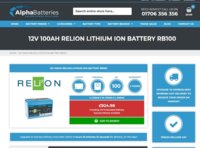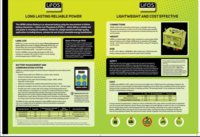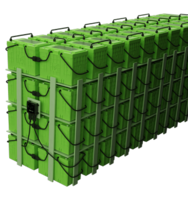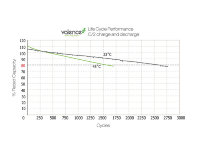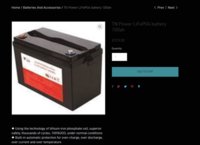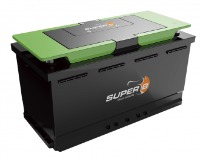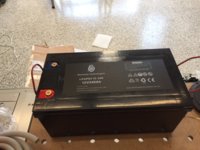Lithium Batteries are the future,
(keep checking back for the latest news/edits)
**************************************************
Dellmassive`s -- "how I Done It" -- Thread
**************************************************
Kit List And Stuff -- How I Done It & What I Use --
**************************************************
we already have them in phones, tablets, laptops, vape sticks, Tesla cars . . . . and now cars & Vans.
There have been a couple of versions of Lithium batteries . . . . and some scare stories associated with them.
wiki - Lithium-ion battery - Wikipedia
in a nutshell the previous types had some issues:
liPo (main use in RC) cells needed a fire proof back when charging. (i had one go up in flames after crashing the RC car and the cell went flying through the air and smashed on the conreat, started gassing off then flames . . . . not good!
The new kid on the block is LiFePO4
(Lithium iron phosphate battery - Wikipedia)
its chemistry is safe to use and is looking like a great replacement for your SLA/EFB+/AGM leisure battery setup.
Why Lithium? . . . . well a normal lead acid battery only has 50% usable capacity, that means you can only use 55ah out of a 110ah battery.
so you would need 2x110ah Lead acid batteries to be comparable to 1x 110ah lithium.
extreamly high charge/discahrge rates . . . so you can charge them fast and draw large loads from them without the Voltage sag associated with normal battery. (ie large inverters, pumps, winches, coffee machines etc)
4000 - 10000 charge/discharge cycles - so effectively they could last 10-20years or longer. (lead acid will last 3-5 years)
most have built in BMS (battery monitoring system) and fancy blutooth monitors.
100% DOD - so you can use all the power.
next to no voltdrop or volt sag under load . . . . which is nice.
they are super lightweight compared to standard batteries.
Most LiFepo4 batteries with integrated BMS`s may work fine with your existing charger/solar/dc-dc charger. (But not via SCR/Smart alternator - see later in thread)
Two things to note is that you cant charge them if the temp is below 0degC . . . . some have internal heaters, some chargers like the victron have programable LTD Low-Temp cut outs, so its not realy a major concern. Also most need a separate LBD "Low Battery Voltage Disconnect"
There are some solutions to these later on.
***************************************************************
So when looking for a lithium battery, look for these stats:
How many charge cycles untill 80% health, (cheaper ones have less)
How many real Ah capacity (not equivalent Lead acid capacity)
Integrated BMS? (nearly all have)
Can you add more batteries in parallel/series.? (most are 2-4 max per bank in series, and many more in parrallel)
Can it use a EHU standard charger? (most will, using a lithium profile)
Physical size and dimensions
whats the charge/discharge temp range? (most cant be charged below 0degC)
You may need a LBD (Low battery disconnect)
You may need a LTD (low temp charge disconnect)
Most will self discharge at 1-2% per month
Most like to be stored charged 50-100%
All will be permanently damaged if run totally flat and left without recharge.
*******************************
here are some current available options, and users of them. --- WHOS GOT WHAT ---
Victron SuperPack, - was the original daddy - but expensive and lacks features.
TN is a new player - cheaper, but less total charge cycles (awaiting a review) (@Farnorthsurfer has one ) (@Samro has x2)
Relion - tried & Tested (built in heater)(possibly my fav, but expensive)
LifOS - smaller capacities (nice APP tho) (@ROMANY TAMPIN has one fitted)
Valence U-Charge XP® Series -( Valence U2712Xp lifepo4 lithium battery v2 - Green), can be found cheap on ebay etc (Valence U27-12XP @Dellmassive has three (@Discobadger has two , @Hickey has one (plus many other members now))
Valence U-Charge XP® Series -( Valence U2712Xp lifepo4 lithium battery v1 - Black), can be found cheap on ebay etc - @Deaks has two
Epsilon SB12V1200Wh-M- (built in heater) (possibly my new fav, awesome spec but expensive)(@Salty Spuds has one)
Ultramax - 100Ah 12V LiFePO4 LITHIUM BATTERY (untested)
PowerTech - Lithium-Ion Battery 12V – 100Ah – 1.28kWh – PowerBrick+ (untested)
Renogy - 12V 100AH SMART LITHIUM IRON PHOSPHATE BATTERY (@OllieGBR , @Rapt0rUK , @Jollyvan , @Skyliner33, @BoroBoy has one )
Renogy - 12v 100ah Smart with Heater - (@Dellmassive )
Poweroad Infinity Lithium - 12v 100ah (bluetooth monitor) (@Mick )
Poweroad Infinity Lithium subzero - 12v 100ah (with heater)(bluetooth monitor) - @Dellmassive @DEH has one
ALLIION - ASX_126_Lifepo4 - Australia - @Bill4750
ROAMER - 200Ah seatbase & 230Ah SB - (@Dellmassive , @damo1023, @Donk, @Samro - has one)
others - updates will follow as more info is available.
*********************************
Valence U-Charge XP® Series (12v 45Ah - 144Ah)
U-Charge® XP for 12V, 24V, 36V, 48V up to 1kV Battery
TN Power LiFePO4 battery 100ah
Product Page | travelvolts
(cheaper but has less charge/discharge cycles than some others)
https://www.batterymegastore.co.uk/amfile/file/download/file_id/451/product_id/8649/
''''
Victron SuperPack,
Lithium SuperPack batteries - an all in one solution - Victron Energy
Relion - 12V 100AH RELION LITHIUM ION BATTERY RB100
12v 100AH Relion Lithium ion Battery RB100
LifOS -
LiFOS Advanced Lithium Power (https://irp-cdn.multiscreensite.com/231bdcf7/files/uploaded/Lifos 68 V2 - A4 Brochure.pdf)
68AH Lithium Battery
PowerTech - Lithium-Ion Battery 12V – 100Ah – 1.28kWh – PowerBrick+
Lithium-Ion Battery 12V - 100Ah - 1.28kWh - PowerBrick+ / LiFePO4
Ultramax - 100Ah 12V LiFePO4 LITHIUM BATTERY
Ultramax 100Ah 12V LITHIUM LiFePO4 Battery for Leisure: Amazon.co.uk: Electronics
Epsilon SB12V1200Wh-M
Super B
Epsilon Lightweight Lithium Ion energy / traction battery, 12,5 kg | Super B
Renogy - 12V 100AH SMART LITHIUM IRON PHOSPHATE BATTERY
12V 100Ah Smart Lithium Iron Phosphate Battery (Back Order)

 www.poweroad.com
www.poweroad.com

 www.poweroad.com
www.poweroad.com
Polinvel Novel BT 100A 12v Lifepo4 : LiFePO4 battery Bluetooth Novel Series 12V 100Ah
******************************************
Charging a LifePo4 Battery:
Most chargers now days have a lithium charge profile.
Which seems to be CC/CV and two stages Absorption and float. And a voltage of around 14.2-14.6v absorption and 13.8v float. (check you battery spec sheet)
My battery spec was to charge at 14.6v .... but my chargers are at 14.2v (default lithium profile).... this hasn't been an issue and the battery charged fine.
So any dc-dc or charger with a lithium profile will work..... technically any charger will work provided its CC/CV and at the correct voltage 14.2v -14.6v ish (check you battery spec sheet),(but it might not fully charge it properly if not set to a lithium charge profile) but Im just a bit happier knowing I had the charger set to a lithium profile. So it doesn't seem critical about the voltage, as long as it's over 14.0v... (infact when charging I never saw more than 14.0 across the battery terminals, because as the voltage in the battery rises to near the supply voltage the current drops off.) ( the charger was putting out 14.2 and the battery was sitting at 14.1v 100% charged)
Also without a DC-DC a large lithium flat battery will cause a massive load on any alternator or SCR as shown on the victron testing video below, so be warned ! without a DC-DC you could damage your alternator/SCR setup . . . Also the lithium's sit at a higher charged rest voltage, mines at 13.8v so you defiantly dont want to add it to a system with a SCR and a AGM starter battery at 12.4V - the lithium will try and discharge into the AGM starter . . . . . so id say a DC-DC is a must for Lifepo4. . . . . some manufacturers say you dont need a special charger and they will charge off the alternator, which is true to a degree, but as you see below victron vid there is a very good chance you will fry your alternator and SCR. The other thing is most Lithiums state the max charge voltage is 14.6v (going above this will damage the battery) . . . . with our smart alternators we see 15.0v during regeng braking (most internal BMS will disconnect the battery at high voltage, but thats a safety thing and not for every day use.) . . . . . So can we use a Lifepo4 battery on a T6 EU6 without a DC-DC charger? - - - - simple answer is no.
My battery started at 12.8v ...
Which was basically about 10% charged.... then showed a gradual rise as it was charging... and ended up at 14.0v..... then dropped to 13.8v after resting a while.
I also tried it on the victron mppt 100/20 solar on the shed.... that worked fine too...... I just changed the battery type in the victron mppt 100/20 menu to lithium....it started charging up go the max current it could....which yesterday was about 8-12amps.
FWIW I'll be upgrading my redarc bcdc1240 DC-DC charger for the bcdc1250d because the new one has a lithium charge profile and built in MPPT, but ill still be using a 3rd party Victron MPPT. also the increased 50A charge rate will decrease the recharge time(running on the OEM 80Afuse/100Arelay / feed cables from the factory SCR setup (fuses and relay have been removed)).
**********************************************************************************
You may also need these depending on your usage scenario: (more details later in thread)
You may need a LBD (Low battery disconnect)
You may need a LTD (low temp charge disconnect)
************************************************************************************
Why you should not charge a LiFePO4 battery below 0 degrees
If you have a Lithium (LiFePO4) battery, there are some things to consider when charging under extreme temperature
conditions.
Lithium battery manufacturers often state an operational temperature range of -30°C to +80°C / -22°F to +176°F
and an optimal temperature range of -10°C to +50°C / 14°F to 122°F (this varies depending on brand and
model, consult your manufacturer). This is often misconstrued as a safe temperature range for both charging and
discharging, this is not the case. The operational temperature range is referring to discharging the battery only.
Charging a Lithium battery in ambient temperatures below 0°C / 32°F must be avoided. The reason for this is it may
potentially damage the battery and / or reduce its lifespan.
The optimum ambient temperature for charging a Lithium battery is +5°C to +45°C / 41°F to 113°F.
When attempting to charge a Lithium battery below 0°C / 32°F a chemical reaction referred to as “Lithium Plating”
occurs. Lithium plating is caused by the charge current forcing the lithium ions to move at a faster reaction rate and
accumulate on the surface of the anode.
When this chemical reaction occurs, the internal resistance of the battery increases and reduces the rate of chemical
metabolism. This chemical reaction causes a permanent reduction of the battery’s capacity and will continue to
reduce its capacity each time this reaction occurs.
If you plan on using a Lithium battery in a location that may drop below 0°C / 32°F, you must be cautious as to when
you attempt to charge the battery. Simply waiting for the temperature to raise during the day is a simple solution.
Having the batteries mounted in a location that will have a higher ambient temperature than outside temperature is
also advisable.
Having a battery management system that can monitor the batteries temperature will be beneficial and convenient.
With the touch of a button you can see what the standing temperature of the battery is and therefore whether it is
safe to charge.
Why you should not charge a lithium battery below 0 | REDARC Electronics
**************************************************************************************
LiFePO4 Battery Buyers Guide! Battleborn vs. Renogy vs. DIY vs. Simpliphi and more!
.
How to not blow up your Alternator when charging Lithium
.
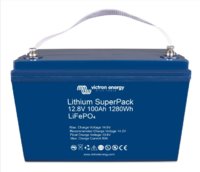

**********************************************
The 2019 Nobel Prize in Chemistry - Lithium Ion Batteries
.
***********************************
Diagrams, Schematics & Wires -- How I Done It --
***********************************
******************************************************
******************************************************
From my experience these are the IMPORTANT FACTS ABOUT LITHIUM batteries:
DO NOT OVER CHARGE THEM, (USE A CHARGER FIT FOR PURPOSE ie CC/CV lithium charge profile)
DO NOT RUN THEM 100% FLAT, (TRY TO RECHARGE BEFORE 10-20%)
Keep Them Between 20-80% SOC/DOD for max life life expectancy,
STORE THEM AT 50% IF PUT INTO STORAGE FOR A LONG TIME, (2-3months or more)
USE THE CORRECT CHARGER / METHOD, (LITHIUM PROFILE OR SUPPLIED CHARGER)
DO NOT SUBJECT THEM TO HIGH TEMPS (IN VAN/CAR/TENT/CAMPER ETC) (Try to KEEP BELOW 35degC)
DO NOT SUBJECT THEM TO VERY LOW TEMPS/FREEZING (Charging) (IN VAN/CAR/TENT/CAMPER ETC) (below 0degC)
DONT LET THEM GET WET (IE OUT IN THE RAIN) UNLESS THEY ARE IP RATED
STICK WITH A KNOWN BRAND NAMES, - unbranded batterys and cells may have failed quality control elsewhere,
REMEMBER YOU GET WHAT YOU PAY FOR, SO CHEAP UNBRANDED IMPORTS MAY HAVE SUBSTANDARD PARTS THAT MAY HAVE FAILED QUALITY CONTROL WITH OTHER MANUFACTURERS.
STAY AWAY FROM LIPO CELLS. (older lithium tech)
******************************************************
******************************************************
.
(keep checking back for the latest news/edits)
**************************************************
Dellmassive`s -- "how I Done It" -- Thread
**************************************************
Kit List And Stuff -- How I Done It & What I Use --
**************************************************
we already have them in phones, tablets, laptops, vape sticks, Tesla cars . . . . and now cars & Vans.
There have been a couple of versions of Lithium batteries . . . . and some scare stories associated with them.
wiki - Lithium-ion battery - Wikipedia
in a nutshell the previous types had some issues:
liPo (main use in RC) cells needed a fire proof back when charging. (i had one go up in flames after crashing the RC car and the cell went flying through the air and smashed on the conreat, started gassing off then flames . . . . not good!
The new kid on the block is LiFePO4
(Lithium iron phosphate battery - Wikipedia)
its chemistry is safe to use and is looking like a great replacement for your SLA/EFB+/AGM leisure battery setup.
Why Lithium? . . . . well a normal lead acid battery only has 50% usable capacity, that means you can only use 55ah out of a 110ah battery.
so you would need 2x110ah Lead acid batteries to be comparable to 1x 110ah lithium.
extreamly high charge/discahrge rates . . . so you can charge them fast and draw large loads from them without the Voltage sag associated with normal battery. (ie large inverters, pumps, winches, coffee machines etc)
4000 - 10000 charge/discharge cycles - so effectively they could last 10-20years or longer. (lead acid will last 3-5 years)
most have built in BMS (battery monitoring system) and fancy blutooth monitors.
100% DOD - so you can use all the power.
next to no voltdrop or volt sag under load . . . . which is nice.
they are super lightweight compared to standard batteries.
Most LiFepo4 batteries with integrated BMS`s may work fine with your existing charger/solar/dc-dc charger. (But not via SCR/Smart alternator - see later in thread)
Two things to note is that you cant charge them if the temp is below 0degC . . . . some have internal heaters, some chargers like the victron have programable LTD Low-Temp cut outs, so its not realy a major concern. Also most need a separate LBD "Low Battery Voltage Disconnect"
There are some solutions to these later on.
***************************************************************
So when looking for a lithium battery, look for these stats:
How many charge cycles untill 80% health, (cheaper ones have less)
How many real Ah capacity (not equivalent Lead acid capacity)
Integrated BMS? (nearly all have)
Can you add more batteries in parallel/series.? (most are 2-4 max per bank in series, and many more in parrallel)
Can it use a EHU standard charger? (most will, using a lithium profile)
Physical size and dimensions
whats the charge/discharge temp range? (most cant be charged below 0degC)
You may need a LBD (Low battery disconnect)
You may need a LTD (low temp charge disconnect)
Most will self discharge at 1-2% per month
Most like to be stored charged 50-100%
All will be permanently damaged if run totally flat and left without recharge.
*******************************
here are some current available options, and users of them. --- WHOS GOT WHAT ---
Victron SuperPack, - was the original daddy - but expensive and lacks features.
TN is a new player - cheaper, but less total charge cycles (awaiting a review) (@Farnorthsurfer has one ) (@Samro has x2)
Relion - tried & Tested (built in heater)(possibly my fav, but expensive)
LifOS - smaller capacities (nice APP tho) (@ROMANY TAMPIN has one fitted)
Valence U-Charge XP® Series -( Valence U2712Xp lifepo4 lithium battery v2 - Green), can be found cheap on ebay etc (Valence U27-12XP @Dellmassive has three (@Discobadger has two , @Hickey has one (plus many other members now))
Valence U-Charge XP® Series -( Valence U2712Xp lifepo4 lithium battery v1 - Black), can be found cheap on ebay etc - @Deaks has two
Epsilon SB12V1200Wh-M- (built in heater) (possibly my new fav, awesome spec but expensive)(@Salty Spuds has one)
Ultramax - 100Ah 12V LiFePO4 LITHIUM BATTERY (untested)
PowerTech - Lithium-Ion Battery 12V – 100Ah – 1.28kWh – PowerBrick+ (untested)
Renogy - 12V 100AH SMART LITHIUM IRON PHOSPHATE BATTERY (@OllieGBR , @Rapt0rUK , @Jollyvan , @Skyliner33, @BoroBoy has one )
Renogy - 12v 100ah Smart with Heater - (@Dellmassive )
Poweroad Infinity Lithium - 12v 100ah (bluetooth monitor) (@Mick )
Poweroad Infinity Lithium subzero - 12v 100ah (with heater)(bluetooth monitor) - @Dellmassive @DEH has one
ALLIION - ASX_126_Lifepo4 - Australia - @Bill4750
ROAMER - 200Ah seatbase & 230Ah SB - (@Dellmassive , @damo1023, @Donk, @Samro - has one)
others - updates will follow as more info is available.
*********************************
Valence U-Charge XP® Series (12v 45Ah - 144Ah)
U-Charge® XP for 12V, 24V, 36V, 48V up to 1kV Battery
TN Power LiFePO4 battery 100ah
Product Page | travelvolts
(cheaper but has less charge/discharge cycles than some others)
https://www.batterymegastore.co.uk/amfile/file/download/file_id/451/product_id/8649/
''''
Victron SuperPack,
Lithium SuperPack batteries - an all in one solution - Victron Energy
Relion - 12V 100AH RELION LITHIUM ION BATTERY RB100
12v 100AH Relion Lithium ion Battery RB100
LifOS -
LiFOS Advanced Lithium Power (https://irp-cdn.multiscreensite.com/231bdcf7/files/uploaded/Lifos 68 V2 - A4 Brochure.pdf)
68AH Lithium Battery
PowerTech - Lithium-Ion Battery 12V – 100Ah – 1.28kWh – PowerBrick+
Lithium-Ion Battery 12V - 100Ah - 1.28kWh - PowerBrick+ / LiFePO4
Ultramax - 100Ah 12V LiFePO4 LITHIUM BATTERY
Ultramax 100Ah 12V LITHIUM LiFePO4 Battery for Leisure: Amazon.co.uk: Electronics
Epsilon SB12V1200Wh-M
Super B
Epsilon Lightweight Lithium Ion energy / traction battery, 12,5 kg | Super B
Renogy - 12V 100AH SMART LITHIUM IRON PHOSPHATE BATTERY
12V 100Ah Smart Lithium Iron Phosphate Battery (Back Order)

12V LINC INFI LiFePO4 Rechargeable Battery
We're known as one of the most professional 12v linc infi LiFePO4 rechargeable battery manufacturers and suppliers. Welcome to buy or wholesale customized 12v linc infi LiFePO4 rechargeable battery from our factory. All custom made products are with high quality and competitive price.

12V LINC INFI Low Temperature Lithium Battery
We're known as one of the most professional 12v linc infi low temperature lithium battery manufacturers and suppliers. Welcome to buy or wholesale customized 12v linc infi low temperature lithium battery from our factory. All custom made products are with high quality and competitive price.
Polinvel Novel BT 100A 12v Lifepo4 : LiFePO4 battery Bluetooth Novel Series 12V 100Ah
******************************************
Charging a LifePo4 Battery:
Most chargers now days have a lithium charge profile.
Which seems to be CC/CV and two stages Absorption and float. And a voltage of around 14.2-14.6v absorption and 13.8v float. (check you battery spec sheet)
My battery spec was to charge at 14.6v .... but my chargers are at 14.2v (default lithium profile).... this hasn't been an issue and the battery charged fine.
So any dc-dc or charger with a lithium profile will work..... technically any charger will work provided its CC/CV and at the correct voltage 14.2v -14.6v ish (check you battery spec sheet),(but it might not fully charge it properly if not set to a lithium charge profile) but Im just a bit happier knowing I had the charger set to a lithium profile. So it doesn't seem critical about the voltage, as long as it's over 14.0v... (infact when charging I never saw more than 14.0 across the battery terminals, because as the voltage in the battery rises to near the supply voltage the current drops off.) ( the charger was putting out 14.2 and the battery was sitting at 14.1v 100% charged)
Also without a DC-DC a large lithium flat battery will cause a massive load on any alternator or SCR as shown on the victron testing video below, so be warned ! without a DC-DC you could damage your alternator/SCR setup . . . Also the lithium's sit at a higher charged rest voltage, mines at 13.8v so you defiantly dont want to add it to a system with a SCR and a AGM starter battery at 12.4V - the lithium will try and discharge into the AGM starter . . . . . so id say a DC-DC is a must for Lifepo4. . . . . some manufacturers say you dont need a special charger and they will charge off the alternator, which is true to a degree, but as you see below victron vid there is a very good chance you will fry your alternator and SCR. The other thing is most Lithiums state the max charge voltage is 14.6v (going above this will damage the battery) . . . . with our smart alternators we see 15.0v during regeng braking (most internal BMS will disconnect the battery at high voltage, but thats a safety thing and not for every day use.) . . . . . So can we use a Lifepo4 battery on a T6 EU6 without a DC-DC charger? - - - - simple answer is no.
My battery started at 12.8v ...
Which was basically about 10% charged.... then showed a gradual rise as it was charging... and ended up at 14.0v..... then dropped to 13.8v after resting a while.
I also tried it on the victron mppt 100/20 solar on the shed.... that worked fine too...... I just changed the battery type in the victron mppt 100/20 menu to lithium....it started charging up go the max current it could....which yesterday was about 8-12amps.
FWIW I'll be upgrading my redarc bcdc1240 DC-DC charger for the bcdc1250d because the new one has a lithium charge profile and built in MPPT, but ill still be using a 3rd party Victron MPPT. also the increased 50A charge rate will decrease the recharge time(running on the OEM 80Afuse/100Arelay / feed cables from the factory SCR setup (fuses and relay have been removed)).
**********************************************************************************
You may also need these depending on your usage scenario: (more details later in thread)
You may need a LBD (Low battery disconnect)
You may need a LTD (low temp charge disconnect)
************************************************************************************
Why you should not charge a LiFePO4 battery below 0 degrees
If you have a Lithium (LiFePO4) battery, there are some things to consider when charging under extreme temperature
conditions.
Lithium battery manufacturers often state an operational temperature range of -30°C to +80°C / -22°F to +176°F
and an optimal temperature range of -10°C to +50°C / 14°F to 122°F (this varies depending on brand and
model, consult your manufacturer). This is often misconstrued as a safe temperature range for both charging and
discharging, this is not the case. The operational temperature range is referring to discharging the battery only.
Charging a Lithium battery in ambient temperatures below 0°C / 32°F must be avoided. The reason for this is it may
potentially damage the battery and / or reduce its lifespan.
The optimum ambient temperature for charging a Lithium battery is +5°C to +45°C / 41°F to 113°F.
When attempting to charge a Lithium battery below 0°C / 32°F a chemical reaction referred to as “Lithium Plating”
occurs. Lithium plating is caused by the charge current forcing the lithium ions to move at a faster reaction rate and
accumulate on the surface of the anode.
When this chemical reaction occurs, the internal resistance of the battery increases and reduces the rate of chemical
metabolism. This chemical reaction causes a permanent reduction of the battery’s capacity and will continue to
reduce its capacity each time this reaction occurs.
If you plan on using a Lithium battery in a location that may drop below 0°C / 32°F, you must be cautious as to when
you attempt to charge the battery. Simply waiting for the temperature to raise during the day is a simple solution.
Having the batteries mounted in a location that will have a higher ambient temperature than outside temperature is
also advisable.
Having a battery management system that can monitor the batteries temperature will be beneficial and convenient.
With the touch of a button you can see what the standing temperature of the battery is and therefore whether it is
safe to charge.
Why you should not charge a lithium battery below 0 | REDARC Electronics
**************************************************************************************
LiFePO4 Battery Buyers Guide! Battleborn vs. Renogy vs. DIY vs. Simpliphi and more!
.
How to not blow up your Alternator when charging Lithium
.


**********************************************
The 2019 Nobel Prize in Chemistry - Lithium Ion Batteries
.
***********************************
Diagrams, Schematics & Wires -- How I Done It --
***********************************
******************************************************
******************************************************
From my experience these are the IMPORTANT FACTS ABOUT LITHIUM batteries:
DO NOT OVER CHARGE THEM, (USE A CHARGER FIT FOR PURPOSE ie CC/CV lithium charge profile)
DO NOT RUN THEM 100% FLAT, (TRY TO RECHARGE BEFORE 10-20%)
Keep Them Between 20-80% SOC/DOD for max life life expectancy,
STORE THEM AT 50% IF PUT INTO STORAGE FOR A LONG TIME, (2-3months or more)
USE THE CORRECT CHARGER / METHOD, (LITHIUM PROFILE OR SUPPLIED CHARGER)
DO NOT SUBJECT THEM TO HIGH TEMPS (IN VAN/CAR/TENT/CAMPER ETC) (Try to KEEP BELOW 35degC)
DO NOT SUBJECT THEM TO VERY LOW TEMPS/FREEZING (Charging) (IN VAN/CAR/TENT/CAMPER ETC) (below 0degC)
DONT LET THEM GET WET (IE OUT IN THE RAIN) UNLESS THEY ARE IP RATED
STICK WITH A KNOWN BRAND NAMES, - unbranded batterys and cells may have failed quality control elsewhere,
REMEMBER YOU GET WHAT YOU PAY FOR, SO CHEAP UNBRANDED IMPORTS MAY HAVE SUBSTANDARD PARTS THAT MAY HAVE FAILED QUALITY CONTROL WITH OTHER MANUFACTURERS.
STAY AWAY FROM LIPO CELLS. (older lithium tech)
******************************************************
******************************************************
.
Last edited:

